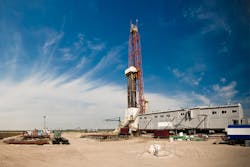Produced water is a byproduct of oil and gas production — the associated water that is produced along with oil or gas during normal production operations. Generally, it includes formation water, condensation water and reproduced injection water. It may also include water used for desalting the oil during production.
Produced water is a complex mixture and has wide variations in composition within and between fields, as well as with the age of fields. The following produced water composition parameters are often referenced:
Hydrocarbon content: aliphatic, aromatic hydrocarbons including single ring aromatics (benzene, toluene, ethylbenzene and xylene [BTEX]), 2-3 ring aromatics (naphthalene, phenanthrene and dibenzothiophene), and polycyclic aromatic hydrocarbons (PAHs). These can be dispersed or dissolved.
Soluble organics: naphthenic acids, carboxylic acids and phenols. These can be present in both dispersed and dissolved form, depending on the pH of the water.
- Total dissolved solids (TDS)
- Total suspended solids (TSS)
- Production chemicals
- Heavy metals
- Radioactive materials
- Dissolved gas (H2S, CO2)
As fields become mature, more produced water is produced with an increasing water cut. Therefore, water production often becomes a limiting factor for continuing oil production economically.
Produced water volume
Worldwide, it is estimated on average that for every barrel (bbl) of oil produced, there are roughly four to five barrels of water coproduced. Because of this, oil companies have sometimes been referred to as water companies within the oil and gas industry.
In the U.S., it was estimated that some 21 billion bbl of water was produced in oil and gas production in 2012, which is equivalent to 57.5 million bbl per day. The average water-to-oil ratio in the U.S. in 2012 was 9.2 bbl of water generated for every 1 bbl of oil. In Oman, data from Petroleum Development of Oman (PDO) showed that the water-to-oil ratio is about 10 bbl of water per 1 bbl of oil.
In the North Sea, official figures from OSPAR Commission confirm that, on average, 7.1 million bbl of produced water was produced every day in 2014. The water-to-oil ratio in the North Sea in 2014 was roughly about 2.3 bbl water per 1 bbl of oil.
Figure 1. Produced water compositions. Courtesy of TUV SUD NEL
Management practice
Produced water is inevitable in oil and gas production. The question is how to best manage this water so that oil and gas can be produced in an economically viable, socially responsible and environmentally sustainable manner.
Management of produced water varies with operators, geographical locations and field history, but some considerations include:
- Identifying sources of water production
- Using water shutoff technologies
- Deploying downhole separation and produced water reinjection (PWRI) systems
- Surface treatment for discharge, reinjection (either for pressure maintenance or disposal) or reuse
- Implementing subsea separation and PWRI systems
- Environmental compliance and monitoring
A good produced water management practice would involve different disciplines — including reservoir engineers, production engineers, chemists and environmental engineers. It would also use an integrated approach, taking into consideration the aforementioned options, as well as the anticipated production history and profile.
Produced water and flowback water
In recent years, there has been a revolution in shale gas and shale oil production using hydraulic fracturing. This revolution has made the U.S. the largest producer for both natural gas and crude oil.
For both shale oil and gas production, a significant amount of water is used for hydraulic fracturing operations. Typically, this can be in the range of 1.5 million gallons (35,714 bbl) to about 16 million gallons (380,952 bbl) per well. Up to 50 percent of this water can return back to the surface along with the initial production, which is referred to as flowback water. Water generated after the flowback period during the lifetime of oil and gas production is commonly termed as produced water in conventional oil and gas production.
The distinction between flowback water and produced water can be subjective. But in general, flowback water is less saline and contains chemicals that are used as part of hydraulic fracturing fluids. There is much less water produced from shale oil production compared to that from conventional oil production.
In the U.K., shale gas and oil exploration and production are at a relatively early stage. TUV SUD NEL published a review of flow- and water-related issues, which was aimed at accelerating safe and responsible developments of U.K. shale gas and oil resources.
Regulatory requirements
Discharge of produced water is strictly regulated, although discharge standards vary with location. The quality of produced water is most widely expressed in terms of its oil content, which acts as a surrogate for other pollutants. Most countries regulate the discharge of produced water, taking into account differing environmental conditions and sensitivities between onshore and offshore. For offshore, regulatory requirements developed in the North Sea and those in the U.S. are often regarded as models that others tend to follow.
Offshore
In the North Sea, the monthly average of oil in discharged produced water must be less than 30 mg/L, with a minimum of 16 samples taken at equal time intervals as demanded by OSPAR.
In the U.K., at least two samples are taken at equal time intervals per day. The measurement method for oil in water for regulatory reporting is the OSPAR GC-FID (Gas Chromatography and Frame Ionization Detection) method, which is a modified version of the ISO 7377-2 method. From 2012, a risk-based approach (RBA) was introduced and implemented. The ultimate aim for OSPAR is to achieve a target in which discharge of produced water would cause no harm to the marine environment.
In the Gulf of Mexico, the discharge standard is 29 mg/L monthly average and 42 mg/L daily maximum. Samples for oil and grease monitoring should be collected and analyzed a minimum of once per month. In addition, a produced water sample should be collected within two hours when an oil sheen is observed in the vicinity of the discharge or within two hours after system startup if it is shut down following an oil sheen discovery, and then it should be analyzed for oil and grease. Oil and grease are measured by the U.S. Environmental Protection Agency (EPA) method 1664.
Toxicity analysis is also required to be carried out. The seven-day average minimum and monthly average minimum of no observable effect concentration (NOEC) must be equal to or greater than the critical dilution concentration as specified by the EPA.
Onshore
Regulatory requirements for discharge are much more stringent onshore. In addition to oil and grease, parameters such as biological oxygen demand (BOD) and chemical oxygen demand (COD), TDS, pH, phenols and heavy methods must meet certain standards.
On average, 75 percent of the produced water offshore is discharged, with the rest being reinjected. Roughly 90 percent of this produced water is reinjected for pressure maintenance or disposal. With the rapid development of shale oil and gas and the demand for water for hydraulic fracturing, there is an increasing emphasis on flowback and produced water reuse.
Figure 2. Produced water management options. Courtesy of Shell
Produced water management challenges
With increasing water production from mature fields, diminishing readily produced oil and more stringent environmental regulations around the world, the industry is increasingly looking into:
- Deepwater and subsea processing, including subsea separation
- Chemical enhanced oil recovery (EOR)
- Heavy oil
- Unconventional oil and gas
However, for each of these options, there are challenges in produced water handling and management. For subsea separation, regardless of whether the separated produced water is discharged or reinjected, water quality must be determined. Yet, there is a significant technology gap in online, continuous oil-in-water measurement technology.
While chemical EOR is well-practiced for onshore, significant challenges remain for offshore operations. This is particularly the case for the effective treatment of the returned produced water to meet discharge or reinjection standards. As for the development of unconventional oil and gas, reuse of flowback water and produced water is increasingly emphasized. Reuse of produced water requires the removal of not only organic compositions, but also TDS. Development of more cost-effective treatment technologies is therefore needed.
In addition to technical issues, the industry also faces challenges in relation to cost reduction under a volatile oil price environment and a shift toward a nonfossil-based cleaner energy.
Conclusion
Management of produced water is crucial in prolonging oil and gas production and maximizing total recovery from a particular field. As the discharge of produced water is strictly regulated, good produced water management will need to involve several disciplines and use an integrated or holistic approach. In addition to using oil in water as a parameter for compliance monitoring, RBA has been introduced and implemented.
With more stringent environmental regulations; increasing water production from mature fields; the move toward deepwater, chemical EORs, heavy oil and unconventional oil and gas production; and a volatile oil price and general shift toward using cleaner energy sources, the oil and gas industry is facing a number of challenges related to produced water management in terms of technology development and cost reduction. A successful produced water management strategy uses an integrated approach, taking into consideration the aforementioned options, geographic location and anticipating production history and profile.
About the Author

Ming Yang
Dr. Ming Yang is a principal consultant at TÜV SÜD National Engineering Laboratory, a global center of excellence for flow measurement and fluid flow systems. A world-class provider of technical consultancy, research and development, testing, and calibration services to the oil and gas, water and energy sectors, the company is the UK’s Designated Institute for Flow and Density measurement, under contract from BEIS, and part of the UK’s National Measurement System.



